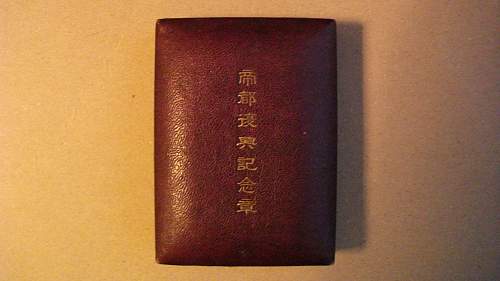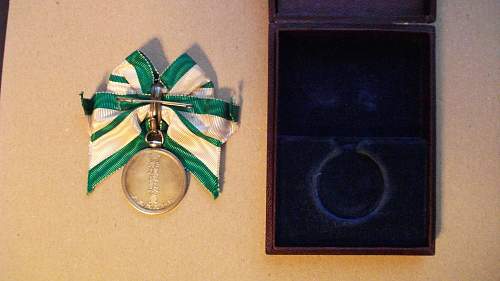Commemorative Medals of the Empire of Japan
Article about: Commemorative Medals of the Empire of Japan Foreword As I had already finished writing a complete history of Japanese War Medals, I thought I might start something on the commemorative medal
-

Thanks for your comment. Yes, most medals also had female versions. Even if a female version may not have been officially established, aftermarket ribbons easily allowed conversion, so more female versions exist than were ever issued. I took the liberty of being male chauvinistic in my discussion of medal designs and have not been overly attentive about which medals officially had women's models. Official documents equally tend to treat this matter as an afterthought and often ignored the point.
-
-


by
Gulik

could find out how to post pictures. here my ladies version of the Capital rehabilitation medal. unforunately, I have never seen an award document to a women.
Regards, pieter


somehow this picture didn't get through, so once more
-
-

The Meiji Zeitgeist
Writing about Japan's Meiji period always reminds me of my own youth and the boundless promise youth holds in changing the world. Yet unlike the waywardness of modern youth that often stray into socially unconstructive behaviour, youth of the Meiji era were crystal clear in their vision of the future and incredibly focussed on their ideals.
This spirit, unique to the Meiji era had been beautifully expressed by novelist, Ryotaro Shiba in his opening words for the book "Clouds Above the Hill", the story of the Russo-Japanese War. Here that paragraph is being beautifully recited by Ken Watanabe and I am honored to provide a full translation of that narrative below.
"The little nation was approaching its day of transformation.
Tiny was Japan as a nation as it neared the dawning of the Meiji Era.
Agriculture was its only industry, and the former Samurai class, who had been the bookworms of society for the past 300 years, was its only human resource.
Through the process of the Meiji Restoration, for the first time, the Japanese people learned of the modern concept of a “Nation”, and everyone was now its “Citizen”. These new “citizens”, the first ever to experience this groundbreaking transformation, felt giddy from the "newness" of it all.
Those who cannot imagine this pure child-like excitement of those times will never be able to grasp the essence of the historical dynamics of this era.
Whatever social class or family you came from, if you just possessed enough qualities of perseverance and the ability to memorize things towards a certain qualification, nothing could prevent you from becoming a professor, bureaucrat, soldier or educator.
The invigorating, free social spirit of these days comes from this sense of optimism.
Thinking back, it is almost laughable that these citizens of a country, who could only boast of rice and silk as its main produce, could even entertain the idea of having a navy equal to the advanced nations of Europe, not to say anything about an Army.
There was no way for a national budget to allow such ambitions. However, creating a modern nation had always been the desire that drove the Meiji Restoration, and it remained a childlike lingering ambition of the whole population into the new era.
This is the story of how that little nation faced a challenge from Russia, one of the oldest great nations of Europe, and how it conducted itself in that conflict.
Perhaps the real main protagonist of this story is the tiny land of Japan itself, but to tell you this story we will be tracing the lives of three men. In Iyo Matsuyama of Shikoku Island, lived these three characters.
Saneyuki Akiyama, who was born in this old town flourishing beside a castle, designed and carried out maneuvers to beat the Russian Baltic fleet, regarded as close to invincible in those opening days of the Russo-Japanese War.
His elder brother, Yoshifuru Akiyama elevated the fighting skills of the Japanese cavalry and achieved the miraculous feat of beating the Cossack Division, known then as the most powerful cavalry in history. The other character rejuvenated classical Japanese short poetry styles known as Tanka or Haiku by incorporating new elements. He was the poet, Shiki Masaoka.
All three, as a nature typical to those who represented the Meiji Zeitgeist never looked back, as they forged ahead, their gazes firmly fixed upon what was ahead. Should there have been a tuft of white cloud in the blue skies above a climb they were about to negotiate, they would have single-mindedly progressed toward that little white cloud".
Similar Threads
-
-
In Medals, Orders & Decorations
-
In Orders, Medals, Badges, Decorations, & Corresponding Documents
 Posting Permissions
Posting Permissions
- You may not post new threads
- You may not post replies
- You may not post attachments
- You may not edit your posts
-
Forum Rules




 .
.







Bookmarks